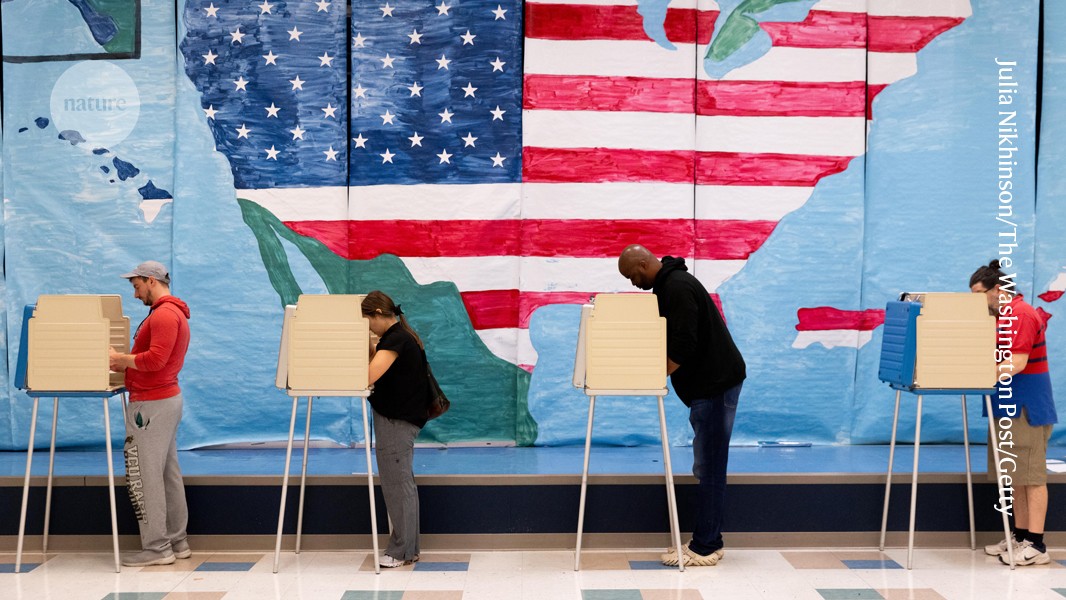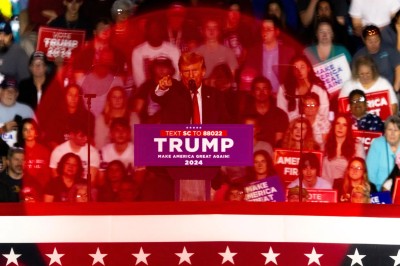The US election being held in November is only the latest in a pivotal year of elections. By the end of 2024, as many as two billion voters will have gone to the polls. For political scientists, this year is a chance not only to dive into each election in detail, but also to compare voting systems. And the active election cycle is reigniting a long-running debate in the field: of the democratic nations that hold free and fair elections, are some electoral systems fairer than others?
Overall, many voters seem to be most in favour of a system known as proportional representation, in which political parties are represented in governments roughly according to their vote share. Voters in democracies that use this system, such as Denmark and Ireland, tend to have relatively high approval ratings for democracy in their nation, and relatively high turnouts. But this pattern is clearest in wealthy countries. There are drawbacks to proportional representation and many nations have stuck with other systems such as ‘first past the post’ (FPTP) and its variants.
What the science of elections can reveal in this super-election year
Scientists hope to explore whether some approaches are more likely to promote democratic resilience or to stave off corrosive partisanship. Such answers might inform policy, but differences in interpretation are inevitable when it comes to politics. “Democracy is a complex system,” says Lee Drutman, a political-science researcher at New America, a think tank in Washington DC. There can be multiple ways to parse the data, he says.
Assessing fairness
When political scientists assess the fairness of electoral systems and voting rules, they typically refer to concepts such as how representative or democratic the systems are. These terms mean different things to different people, but a ‘representative’ electoral system usually refers to the extent to which results proportionally reflect vote shares, says Brian Crisp, a political scientist at Washington University in St. Louis. ‘Democratic’, meanwhile, usually refers to qualities of transparency and accountability to the public.
Viewed through these lenses, trade-offs between the major types of electoral system become apparent. In a FPTP or winner-takes-all system — such as those in the United States and United Kingdom — whoever collects the most votes in a particular district wins, so that voters in a single district are represented by a single winning candidate. Such systems are also referred to as ‘majoritarian’, although typically having more votes than anyone else, even if less than 50%, is enough to win. When the winners are aggregated into a multi-district legislative body, the governing party usually emerges from the party that also got the most individual votes overall — although the US system has generated exceptions to this rule.
There are sub-variants in FPTP systems: ranked-choice voting, which is used, for instance, in Australia, ensures a majority winner. Voters rank all candidates or parties; the lowest-ranked candidate drops out and their supporters’ second-choice preferences are tallied, and so on until a single candidate surpasses a 50% threshold. And run-off elections, such as those in France, when the two leading parties are voted for in a second round, ensure a direct national face-off.
Other countries use a system with both proportional and FPTP elements (see ‘Election systems around the world’). In Germany, for instance, voters elect members of parliament under FPTP, and also get to vote for a party; a second tier of parliamentary seats is allocated to parties in proportion to their vote shares.
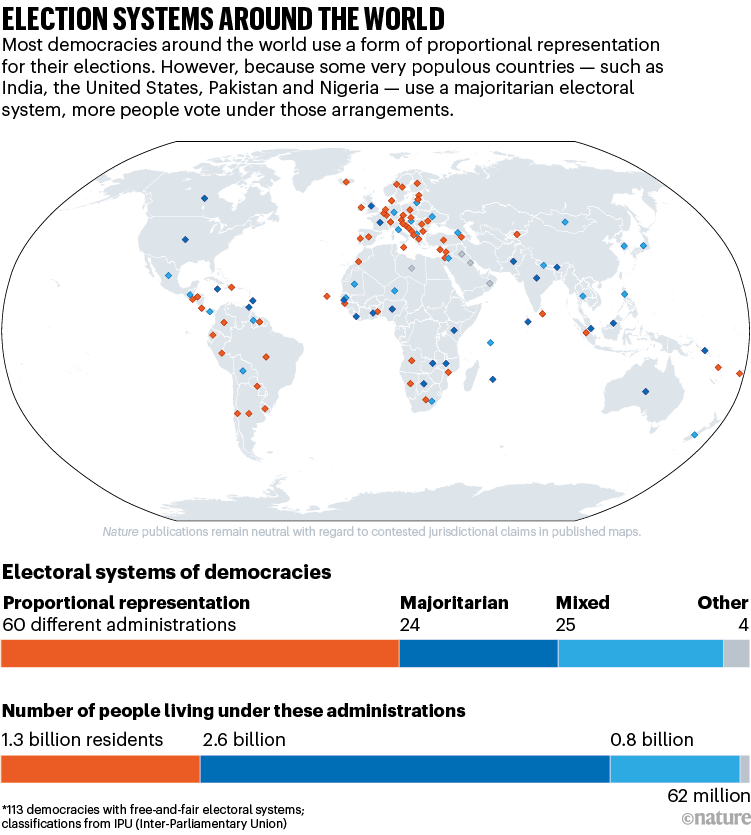
Sources: IPU Parline (electoral systems), World Bank (populations), V-dem via Our World in Data (democracies with free and fair elections)
Majoritarian systems typically have the advantage of accountability, says Crisp. Voters have a clear sense of who is responsible for their district-wide or national policies, and who to reward or punish in the next election.
In proportional systems, by contrast, accountability can be muddier. Those systems are designed such that a party that wins one-quarter of the votes, say, will end up with about one-quarter of the legislative seats. Thus, a second or third place finish in a district will still result in some representation and districts can in effect be represented by candidates from multiple parties. Such systems can lead to several parties receiving sizable vote shares and therefore to coalition governments, with the party that receives the most votes often selecting the head of government.
Compared with FPTP, proportional systems do more obviously represent voters’ preferences, including those of marginalized groups. But no system can be perfectly fair: political scientists sometimes refer to work on social choice in the 1950s by US economist Kenneth Arrow1, who showed that it is impossible to always fairly rank three or more options, such as candidates A, B and C on a ballot, while satisfying logical stipulations, such as that a system that would elect A if B were the only alternative, would also elect A from three candidates. (The problem arises in situations when the presence of C affects individual preferences for A or B — issues which in the real world occur with strategic voting or ‘spoiler’ candidates). “You can’t design a system that doesn’t encounter a trade-off,” says Maggie Penn, a political scientist at Emory University in Atlanta, Georgia.
Giving the public what it wants
Another way of looking at the fairness issue suggests that proportional representation tends to produce government policies that better represent what the public desires. Political scientists examine the extent of ‘responsiveness’ of electoral systems, whether elected bodies respond to changing public opinion; and ‘congruence’, whether the policies put in place match those desired by the public. As an example, suppose a state had a ban on abortion after 6 weeks of pregnancy, but the public wanted it banned only after 26 weeks, and elected officials responded by changing the law to a ban after 15 weeks of pregnancy. Such a shift would be responsive but not congruent.
Proportional-representation systems seem to have more policy congruence than do majoritarian ones, which are responsive to public preferences but not always congruent, according to research based on data from the Organisation for Economic Co-operation and Development2. But majoritarian systems typically do have congruence between an elected official and the average voter, in the sense that the most popular policy positions among voters are often reflected by the policies put in place, Crisp says, even though the full range of policies does not necessarily reflect the population’s distribution of preferences in the way that those of a many-party system might.
For decades, researchers have also been exploring the crucial question of whether voters are satisfied with their own democracies and electoral systems, using national election study surveys in dozens of countries (see ‘Satisfaction with democratic systems’). “The side of the debate that seems to be winning is proportional representation, with guarantees of minority representation and minority rights,” says David Samuels, a political scientist at the University of Minnesota in Minneapolis. In such systems, when a party receives, say, 10% of the vote, it will still play a part in the new government, and people backing that party will feel that they have a voice, rather than feeling excluded.
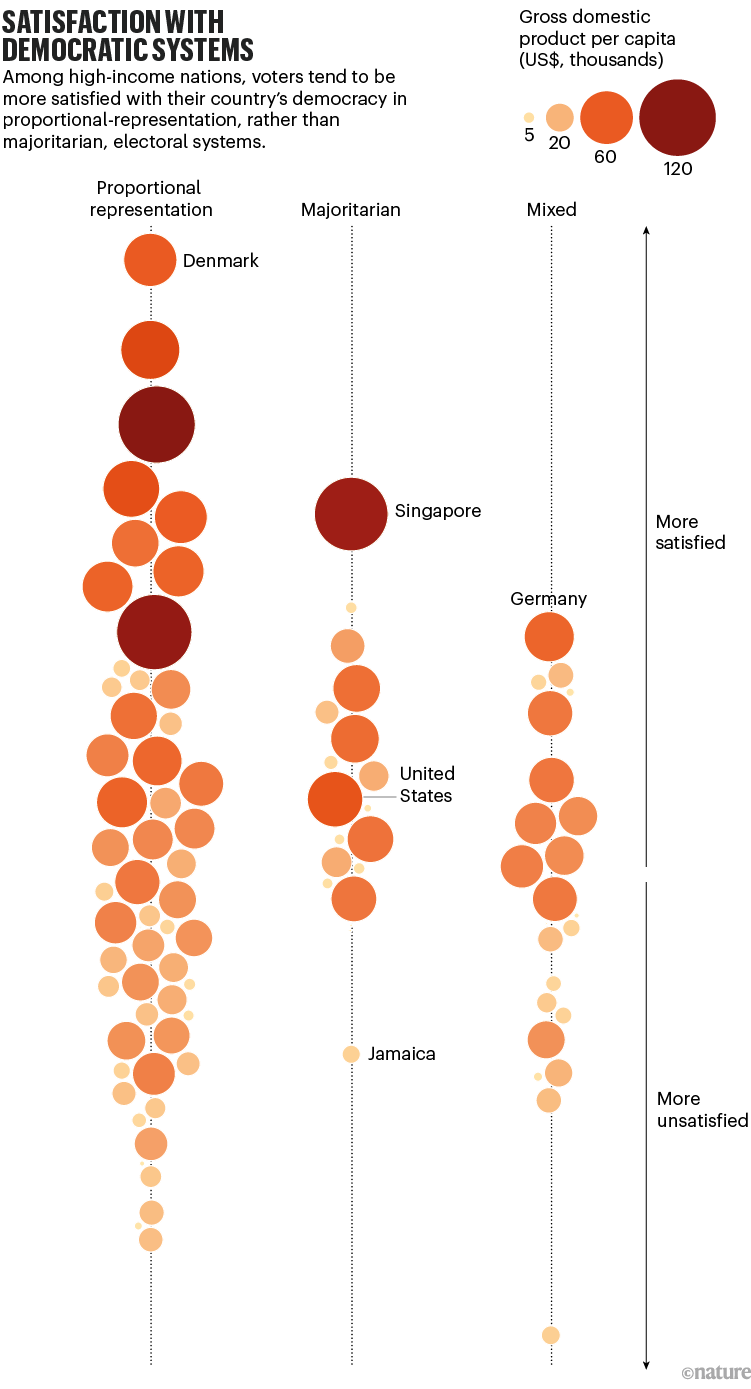
Sources: Claassen (2022) via Our World in Data (satisfaction ratings), OECD (GDP per capita)
But assessments comparing countries with proportional representation and those with majoritarian systems are complicated: for example, voters in Scandinavian countries, Switzerland and the Netherlands are happy with their electoral systems but that might be mostly because their countries are relatively well off compared with others. “Maybe it’s because Sweden is Sweden, and these are rich countries anyway,” Samuels says.
Also contentious is whether countries with proportional representation tend to have higher voter turnout than those with majoritarian elections. Interpretations of voter turnout vary, but a low turnout can mean a lack of engagement or representation and can affect the legitimacy of elections. Among high-income western democracies, turnout rates are higher in countries with proportional-representation systems (after excluding countries with mandatory voting, such as Australia). However, the connection is less clear among a wider set of democracies (see ‘Turnout under different electoral systems’).
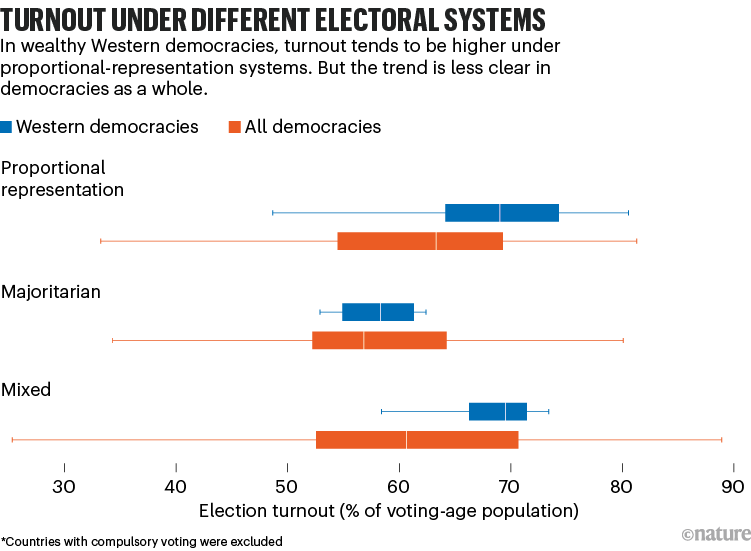
Source: IDEA voter turnout database
New Zealand is often cited as a case study that saw higher turnout after it switched from a UK-style majoritarian system to a German-style mixed-member one. The change emerged from voter opposition to the major parties at the time, and anger over the country’s Labour Party winning the most votes but not gaining power in two elections.
From electoral systems to politics?
Whether variants in electoral systems lead to different politics is a hotly debated topic. In the 1950s, French political scientist Maurice Duverger laid out how majoritarian elections tend to result in a two-party system. That’s because people who support a minor party that is unlikely to win, and who feel that their vote would be wasted or would spoil support for a more popular party, tend to vote strategically for one of the two major ones instead.
How five crucial elections in 2024 could shape climate action for decades
Over the past couple of decades, some researchers have suggested that the two- party dynamic systematically favours right-wing parties, partly for economic reasons. The theory, says Robert Liñeira, a political scientist at the University of Glasgow, UK, is that middle-income voters fear that if they vote for a left-wing party, its preference for economic redistribution policies that benefit people with lower incomes will be unconstrained in a majoritarian winner-takes-all system. A proportional-representation system in which multiple parties can be expected to have influence on who governs would temper those concerns, Liñeira suggests.
In May, he co-authored a study that argues it shows the first empirical evidence for this3. He and Pedro Riera at the Carlos III University of Madrid in Spain, examined two decades of election data from 20 democracies that use either majoritarian or proportional-representation systems. They analysed the choices of voters divided into low-, middle- and upper-income groups. The middle-income voters, the study found, did stand out as behaving differently under different electoral systems, even when taking into account their individual left or right preferences, and controlling for differences in the ideological positions of parties in different countries.
Resilience to breakdown
Perhaps the most urgent question is whether one electoral variant is more resilient to breakdown as a result of the rise of extremist or anti-democratic parties. Proportional representation gives minor parties a voice, and so can let extremist views into political systems, which was seen in the growing support of far-right parties in this year’s European Parliament elections. Having more political parties, however, which tends to happen in countries or international organizations with proportional representation, makes a system more resilient to antidemocratic efforts, argues Drutman. A surprise swing of the pendulum, with the election of an extremist party, doesn’t necessarily destabilize such a system. In the Netherlands, for example, although the far-right Party for Freedom won the most seats in the most recent election, it had to form a coalition with other parties, and the leader had to make concessions in the process.

Voting at an art museum in the Netherlands, where the far-right ‘Freedom Party’ won this year.Credit: Peter Dejong/Associated Press/Alamy
Majoritarian systems tend to squash down smaller parties, including far-right ones — but there’s little recourse if one of the two major parties goes in an extremist direction and wins an election, Drutman says. In recent years, the US two-party system has proved to be vulnerable and is stuck in a ‘doom loop’, according to his research4. In this scenario, US politics becomes increasingly polarized and divisive, with each side viewing the other as not just the opposition but also the enemy. “This is how democratic backsliding happens, when you have a public that is willing to tolerate antidemocratic behaviour because it thinks that winning elections is more important than having elections, essentially,” he says. The system is increasingly alienating people from politics and encouraging toxic partisanship, forces that contribute to democratic fragility, he argues.
Extreme partisanship is not limited to countries with majoritarian elections, says Stuart Soroka, a political-behaviour researcher at the University of California, Los Angeles. Israel, which has proportional representation, is an exception to that trend, he says, although that might be because of the country’s unique political history, as well as to its low electoral threshold (the minimum share of votes required before a candidate or party is entitled to representation). In Israel, this is just 3.25%. This means that very small and extreme parties can gain seats in the country’s parliament, fractionalizing the legislature. Typically, however, countries that produce coalition governments end up with the larger parties moderating the stance of the extreme parties on the fringe.
Making majoritarian systems fairer
The US majoritarian electoral system has particularly acute frustrations when it comes to fair voting, largely owing to its Electoral College system (which was abandoned by every other democracy by the end of the twentieth century). In this system, votes are ultimately cast by just 538 presidential electors, who are assigned to each state in numbers that are only roughly proportional to the number of voters living there. This unevenness gives a handful of states with narrowly divided vote counts more influence on the final vote for president. And for most states, presidential elector votes all go to a single-party winner, after aggregation of the results of district-level elections. Most voters, therefore, find themselves in a predictable single-party state, making it less likely that their vote will produce meaningful change or that their concerns will be reflected in campaigning.
How to tackle political polarization — the researchers trying to bridge divides
On several occasions, most recently in 2016 and in 2000, this system of aggregation has meant that the US election’s winner secured fewer overall votes (albeit more presidential electors) than the runner-up. “The Electoral College is extreme and an anachronism,” says Samuels, “and it’s not going anywhere”.
The quality of US democracy now is clearly better than in the ‘Jim Crow’ era of racial segregation, when Black people’s ability to vote was severely limited in many places; the civil rights movement has led to fewer barriers to voting. Still, surveys show widespread discontent, Samuels says, over issues such as gerrymandering, in which lawmakers map districts to give a single party more seats than it would have earned with fairer maps, and concerns such as right-wing legislators seeking to add new voting restrictions to boost their party’s election chances.
One tweak increasing in popularity has been to bring in ranked choice voting to some state and federal elections. This allows voters to choose third-party or independent candidates ahead of one of the main parties without fear of wasting their vote or spoiling a major contender’s chances, since if that person is eliminated, the voter’s second-preference will be counted. Maine and Alaska have adopted single-winner versions for state and federal elections, and voters in Nevada and Oregon will consider ballot measures regarding them in November. Some areas are also using proportional versions, where rankings are used to fill multiple seats, not just one.
Soroka says that ranked-choice voting might “reap some of the benefits of a standard proportional-representation system and a first-past-the-post system” — but that the empirical evidence is limited. Although there are increasing test cases for this type of system at the local level, says political scientist Carolina Plescia, at the University of Vienna, reform at the general level seems unlikely. And so far, ranked choice in the US majoritarian system has not significantly boosted any third party or displaced the two dominant ones, notes Jack Santucci, a political scientist at Western New England University in Springfield, Massachusetts.
For Drutman, US efforts to incorporate ranked-choice voting can have only a limited effect, and don’t necessarily change the core problem of politics in the country, as he sees it. The system still pushes towards two dominant parties, and avoids proportional representation at the district or state levels. In his view, the goal should be more parties, focused on giving more voters a voice and on building cross-party coalitions, instead of experiments with ranked-choice voting to elect particular candidates. But he does see a positive note from these experiments: “There’s definitely interest in electoral reform.”


